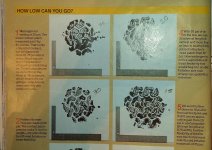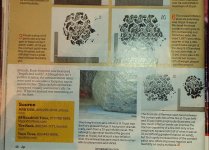You are using an out of date browser. It may not display this or other websites correctly.
You should upgrade or use an alternative browser.
You should upgrade or use an alternative browser.
Recommended tire pressure - on road
- Thread starter Sporadic
- Start date
webejeepin
Member
33 X 11.5 X 17 M/T ATZ PSI for On Road Use
I'll tag along on this thread, even though I'm not running the larger tires some of you folks are.
For my DD use on highway, am I on target if I run these tries between 28 and 30 PSI?
Also, I've heard the experts here refer to a 'chalk test'...here come the newbie question....sidewalk chalk on your tire tread to see if it's....???
Anyone fiil the banks in for me.
Thanks
I'll tag along on this thread, even though I'm not running the larger tires some of you folks are.
For my DD use on highway, am I on target if I run these tries between 28 and 30 PSI?
Also, I've heard the experts here refer to a 'chalk test'...here come the newbie question....sidewalk chalk on your tire tread to see if it's....???
Anyone fiil the banks in for me.
Thanks
Lil Nasty
Member
There are some good videos on YouTube showing what to do.
The basics are using sidewalk chalk to mark a line across the tread of your tire from shoulder to shoulder. Then drive forwards and backwards 50-100' and check your chalk line. You’re looking for even wear across the chalk line. Air down/up and recheck until you find what psi wears properly. I used an old Wal-Mart parking lot. No traffic and flat paved surface unlike a crowned road.
When I bought my jeep the previous owner just installed the tires and it was riding horribly. Found the tires had 45psi in them while being 10 ply. After chalk testing I'm running my 33s at 28-30 psi.
The basics are using sidewalk chalk to mark a line across the tread of your tire from shoulder to shoulder. Then drive forwards and backwards 50-100' and check your chalk line. You’re looking for even wear across the chalk line. Air down/up and recheck until you find what psi wears properly. I used an old Wal-Mart parking lot. No traffic and flat paved surface unlike a crowned road.
When I bought my jeep the previous owner just installed the tires and it was riding horribly. Found the tires had 45psi in them while being 10 ply. After chalk testing I'm running my 33s at 28-30 psi.
Prime8
New member
The force each tire exerts on the ground is the psi in the tire times the area of contact. There are subtle variables but that's the important part.
That is incorrect. The force each tire exerts on the ground is a function of the vehicles mass and that masses interaction with gravity, divided by the area of contact. By your equation, a flat tire would make your car float away. Remove your 28psi tire from your jeep and its still 28psi. The psi in a tire doesn't refer to the psi of the tire on the ground, it refers to the compression of a gas in a confined environment.
OverlanderJK
Resident Smartass
so is the 28-30 psi you guys recommend for tires pressure is warm/hot pressure or is it 28-30 cold? :thinking: :idontknow:
It has to be extreme temperature change to matter. I filled to 28 when it was 95* outside. When I checked it when it was 70* it was still at 28PSI.
cozdude
Guy with a Red 2-Door
It has to be extreme temperature change to matter. I filled to 28 when it was 95* outside. When I checked it when it was 70* it was still at 28PSI.
sorry it sounded different in my head lol what i ment was check it before driving or after driving for a bit?
NFRs2000NYC
Caught the Bug
If you guys have a LONG drive (say from Cali to Moab) will you run more PSI just to get some better MPG and better highway performance?
webejeepin
Member
so is the 28-30 psi you guys recommend for tires pressure is warm/hot pressure or is it 28-30 cold? :thinking: :idontknow:
From all the reading I have done on this topic and measuring its cold.
If I let the jeep sit the night measure in the morning I'm at 31.5 psi. I drive to work on the highway 60km later take another measurement and I'm 34.4 psi. The temp outside was a cool 10c...
Soooo I will air down to 30 in the morning and then try the chalk test see what happens.
On a side note the guys at work think I'm nuts always measuring my tire pressure.....another thread for another time
Last edited:
MobyJR
New member
I currently run 28PSI in my mud grapplers but might bump it up to 30 to see how it feels.
Did like you said and tried 28-30.
Feels like a whole new jeep!
Majik
Member
That is incorrect. The force each tire exerts on the ground is a function of the vehicles mass and that masses interaction with gravity, divided by the area of contact. By your equation, a flat tire would make your car float away. Remove your 28psi tire from your jeep and its still 28psi. The psi in a tire doesn't refer to the psi of the tire on the ground, it refers to the compression of a gas in a confined environment.
I have to have fun with this one and disagree. A flat tire places the rim in contact with the inside of the tire. In this case, my theory is void because now you have the rim directly contacting the ground, with a thin piece of rubber between the two. The car is no longer supported by the air in the tire.
You are right. The force the tire exerts on the ground IS a function of the vehicle's mass and that mass's interaction with gravity. BUT... gravity is constant on this planet, and so mass times a gravity constant is called weight. Unless we are taking our vehicles to Mars, that " function of the vehicle's mass and that mass's interaction with gravity" is more simply referred to on this planet as 'weight'.
Unless the ground is propelling the vehicle upward, the 'weight' of the vehicle on the ground must equal the force the ground exerts on the vehicle through the tires (remember that "for each action there is an equal and opposite reaction " issue?). If I weigh 160lbs and my shoe has a 20 sq in surface area, I exert 8 psi of force on the ground, and the ground exerts 8psi of force on my shoe. If your car was able to balance on one tire only, and the surface area of that tire on the ground is 30 sq in, and the psi in the tire is 60psi, assuming that little weight of the car is held by the sidewall in compression(which is a reasonable assumption - you can pretty easily flex a sidewall between two hands) then the only true supporting structure for the weight of the vehicle is a column of air between the rim and tire. And ROUGHLY then, the weight of the car is 1800lbs.
Fun discussion
OverlanderJK
Resident Smartass
Did like you said and tried 28-30.
Feels like a whole new jeep!
:thumb: glad it worked out for you.
JK1
New member
I have to have fun with this one and disagree. A flat tire places the rim in contact with the inside of the tire. In this case, my theory is void because now you have the rim directly contacting the ground, with a thin piece of rubber between the two. The car is no longer supported by the air in the tire.
You are right. The force the tire exerts on the ground IS a function of the vehicle's mass and that mass's interaction with gravity. BUT... gravity is constant on this planet, and so mass times a gravity constant is called weight. Unless we are taking our vehicles to Mars, that " function of the vehicle's mass and that mass's interaction with gravity" is more simply referred to on this planet as 'weight'.
Unless the ground is propelling the vehicle upward, the 'weight' of the vehicle on the ground must equal the force the ground exerts on the vehicle through the tires (remember that "for each action there is an equal and opposite reaction " issue?). If I weigh 160lbs and my shoe has a 20 sq in surface area, I exert 8 psi of force on the ground, and the ground exerts 8psi of force on my shoe. If your car was able to balance on one tire only, and the surface area of that tire on the ground is 30 sq in, and the psi in the tire is 60psi, assuming that little weight of the car is held by the sidewall in compression(which is a reasonable assumption - you can pretty easily flex a sidewall between two hands) then the only true supporting structure for the weight of the vehicle is a column of air between the rim and tire. And ROUGHLY then, the weight of the car is 1800lbs.
Fun discussionFun banter
Reminds me of old physics classes!
wow.... and the strange thing is that i understand what you said...lol:beer:
Majik
Member
wow.... and the strange thing is that i understand what you said...lol:beer:
I don't think I've ever thought about the air in my friggin tires that much in my life! LOL!! Glad you followed though!
WJCO
Meme King
Airing down Testing contact pattern
I know this is an old thread, but here's an article that JP Magazine published recently showing tire contact patterns at different pressures when lowering air pressures offroad. I found it really cool to visualize. Below is a picture I snapped from the magazine, and the link down below shows a similar article for an online version.


http://www.fourwheeler.com/how-to/tech-qa/1511-why-lowering-tire-pressure-helps-off-road-traction/
I know this is an old thread, but here's an article that JP Magazine published recently showing tire contact patterns at different pressures when lowering air pressures offroad. I found it really cool to visualize. Below is a picture I snapped from the magazine, and the link down below shows a similar article for an online version.


http://www.fourwheeler.com/how-to/tech-qa/1511-why-lowering-tire-pressure-helps-off-road-traction/
